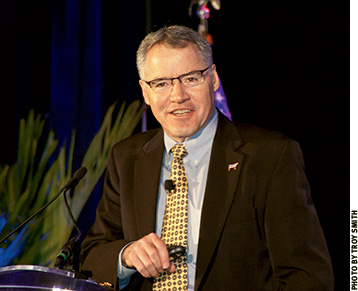Issues Shaping the Future
CattleFax analyst says outlook covers many more issues than 20 years ago because the need demands it.
by Troy Smith for Angus Journal
TAMPA, Fla. (Feb. 8, 2013) — Domestic demand for beef could be described as steady to slightly soft. It’s a reflection of tight beef supplies and resulting higher beef prices, but also a 1% decline in consumers’ per capita disposable income. According to CattleFax market research, a 1% change in real income creates a 1% change in beef demand. Beef supply and demand, the U.S. economy and other issues likely to shape the future were discussed during the CattleFax Annual Outlook Seminar during the 2013 Cattle Industry Convention in Tampa, Fla.

“The cattle feeder, the packer and the retailer didn’t make any money. They’ve been pushing up against a price ceiling for several months,” said Blach. “It’s been a little tough for margin operators.”
According to CattleFax CEO Randy Blach, higher beef prices in 2012 rationed a limited supply of product. The supply will tighten a bit more in 2013, begging the question: “How much are consumers willing to pay?” There probably is a limit, as suggested by consumer resistance to gasoline sales at $4 per gallon.
Blach said he believes beef will struggle to remain price-competitive with pork and chicken even though prices for those alternative protein sources are predicted to increase, as well. Beef will still cost more, and the gap may widen.
While he does not expect the U.S. economy to backslide into recession, Blach doesn’t see much up-side either. He said government policy will heavily influence income levels in 2013. Based on current figures, incomes and gross domestic product (GDP, the market value of all U.S. goods and services) have the potential to decline by as much as 3%.
Fiscal cliff concerns have subsided, but policymakers have yet to balance public concerns related to tax cuts and deficit spending by government. During 2013, Blach expects little improvement in the domestic economy, and the possibility of buyer resistance to higher beef prices. Internationally, however, emergence of new markets and expansion of existing markets should result in aggressive bidding for U.S. beef in 2013.
“As personal incomes in developing countries increase, so does the demand for a higher-quality diet. Global beef consumption is climbing,” said Blach. “We will see (global) population growth of 700 million to 800 million people in the next decade. We’ll see more demand for meat and more opportunity to export beef.”
Blach said exports will play a big role in whether the U.S. beef industry is able to grow, citing the current $280 contribution to the value of a finished steer that is a result of the collective export market. That’s $100 per head more than in 2003, before the U.S. lost much valuable access to foreign markets.
Record-high prices have driven the conversion of more acres into corn production. CattleFax analysts expect corn prices to remain historically high through the first half of 2013, but demand rationing for ethanol production and exports, plus an increase in corn production could pressure prices sharply lower by fall. Blach said he thinks the big push in agricultural land markets may be about to run its course.
Noting how uncertainty creates market volatility, Blach said increases in both capital requirements and risk, without increasing returns, will hinder the cattle industry. Returns to the cattle-feeding segment, in particular, have been exceeded by operating investment and the consequences of price volatility over the last decade. Emphasizing how credit needs have “skyrocketed,” Blach warned that access to capital will be tested. He expects continued volatility will lead more producers to develop risk-management plans.
Pointing to a thinning cash market for fed cattle, with more cattle moved through alternative marketing arrangements, Blach said selling cattle “with the hide off” is shaping into a long-term trend that challenges price discovery.
“Be careful,” advised Blach. “Yes, we’re seeing record prices, but it may be difficult to make money because we also have record breakevens. Manage your risk.”
Urging the audience to contrast current CattleFax reports with those of 20 years ago, and note how reports now cover many more issues in greater detail, Blach said it’s because cattle producers must consider the effects of many more issues.
“Your business demands it,” he concluded.
--------------------
Editor’s Note: The above article was written under contract or by staff of the Angus Journal. It may not be reprinted without express permission of the Angus Journal. To request reprint permission, contact the editor at 816-383-5200.
www.4cattlemen.com is an event coverage site provided by the editorial team at Angus Productions Inc. (API), publisher of the Angus Journal, the Angus Beef Bulletin, the Angus Beef Bulletin EXTRA and the Angus e-List. For questions about this site, to submit an article for our consideration, or to report a broken link, contact the editor at 816-383-5200; 3201 Frederick Ave., Saint Joseph, MO 64506.
API claims copyright to this website as presented. We welcome educational venues and cattlemen to link to this site as a service to their audience.

